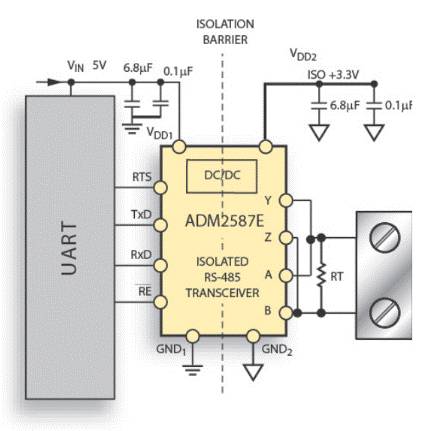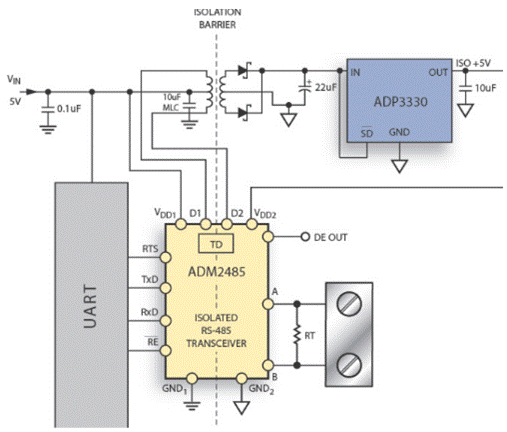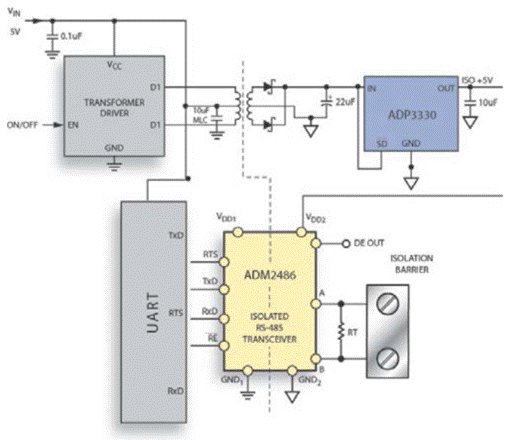
Example sharing Splitting isolated power in isolated RS-485 nodes!
“The isolation of signals and power in an RS-485 node presents design challenges for optimal configuration against system requirements such as small size, low power consumption, data rate, EMI, and bill of materials. Traditional discrete solutions such as optocouplers have problems with failure life, and the physical characteristics of optocoupler technology itself determine high power consumption per channel isolation, which has been discussed in detail in the industry.
“
The isolation of signals and power in an RS-485 node presents design challenges for optimal configuration against system requirements such as small size, low power consumption, data rate, EMI, and bill of materials. Traditional discrete solutions such as optocouplers have problems with failure life, and the physical characteristics of optocoupler technology itself determine high power consumption per channel isolation, which has been discussed in detail in the industry.
In addition, the cost of optocoupler technology increases substantially as data rates increase, and the manufacturing complexity increases as the number of devices increases. The realization of a discrete isolated DC/DC converter requires the designer to have knowledge of transformer design and to be able to match the other power components of the isolated DC/DC converter to the transformer. Designs are susceptible to the parasitic resistance, inductance, and capacitance associated with these devices. Fortunately, there are new, highly integrated isolated transceiver solutions that address these design challenges.
Over the past seven years, ADI has developed a series of innovative integrated isolated RS-485 transceivers that combine ADI’s advanced RS-485 interface technology with iCoupler®Digital signal isolation technology in one, recently combined with ADI’s isoPower®Isolated DC/DC converter technology. These isolated transceiver products are designed for many applications in harsh environments such as: industrial automation, solar and wind energy, instrumentation, power line monitoring, and more. Industrial communication protocols using this series of products include Profibus, Interbus, Modbus, BacNet, etc.
This family of integrated isolated RS-485/422 transceivers provides designers with the best choice of integrated solutions according to the system partitioning of the power chain, especially the isolated bus-side voltage source.
For power chain splitting of isolated RS-485 nodes, ADI generally provides three types of solutions:
• Fully integrated signal and power isolated RS-485/422 solution
• Integrated signal isolation and integrated transformer driver (partial power chain integration)
• Signal-isolated RS-485/RS-422 transceivers that support flexible selection of bus-side voltage sources

Figure 1 shows the compact configuration of the Analog Devices ADM2587E, an integrated signal and power isolated RS-485 transceiver. Such a high level of integration through ADI’s iCoupler®and isoPower isolation technology, the combination of the two results in this product with excellent performance, easier to use than traditional solutions, smaller size, the same RS-485 load required lower input power. The ADM2587E/ADM2582E signal and power isolated RS-485 transceivers are the industry’s smallest solution in a 20-pin wide body SOIC package; they are also integrated signal and power isolated RS-485/RS- 422 transceivers. These products are ideal for customers with tight design time and design size constraints.
In 2007, ADI introduced the ADM2485, a small-footprint Profibus-compatible signal-isolated RS-485 transceiver with an integrated transformer driver and a 16-pin wide-body SOIC package. The ADM2485 is one of three isolated RS-485 transceivers from ADI with integrated transformer driver functionality. Figure 2 shows the ADM2485 driving the primary side of the transformer to deliver isolated power to the bus-side circuitry.

The configuration shown in Figure 2 is highly efficient, with a typical efficiency of 81% from a 5 V input supply, making it suitable for designs with tight temperature constraints. An external transformer allows the DC/DC converter to operate at 500 kHz, which provides a low EMI solution for designs with very stringent emissions requirements. For system designers, the main difference between the solutions shown in Figure 1 and Figure 2 is that the former is smaller and easier to use, while the latter offers higher efficiency and a lower frequency radiated spectrum.
In a typical programmable logic controller design, I/O and communication ports require a variety of isolated power supplies. This requires custom power supplies to generate multiple isolated power supplies, such as ±15 V, 5 V, and 3.3 V, from the same transformer core. In this case, the most economical option is to integrate only an isolated RS-485 transceiver with signal isolation, such as the isolated Profibus compatible RS-485 transceiver ADM2486, giving the flexibility to choose either existing 5 V or 3.3 V isolation The power supply can also utilize a separate winding on the transformer to generate the bus-side isolation voltage. Figure 3 shows a simplified discrete DC/DC converter that illustrates how this configuration can be used with the ADM2486 transceiver.

ADI’s family of isolated RS-485/RS-422 transceivers also offers multiple data rates up to 20 Mbps, up to 256 nodes on a bus, and half- and full-duplex modes of operation. In addition, this series of integrated isolated RS-485 transceivers are all UL, VDE listed, and CSA certification is available upon request. These products are 100% production tested to 3000V rms or 6000 V rms depending on the isolation rating of the product (2.5 kV rms or 5 kV rms).
ADI’s portfolio of integrated RS-485 isolated transceivers offers the flexibility and performance to meet system design requirements, offering many advantages over the optocoupler approach. The iCoupler transformer technology that made it all work was put into mass production in 2001, and 500 million channels have been delivered so far, and its reliability is beyond doubt. The iCoupler has a lifespan of over 50 years without the traditional wear and tear issues that are fundamental flaws in optocoupler technology.
The Links: CM200YE4-12F DG2406427 LCD-DISPLAY


